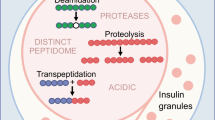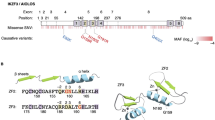Abstract
Predisposition to Type I insulin-dependent diabetes (IDD) has a strong underlying genetic basis involving class II major histocompatibility complex (MHC) genes as well as several non-MHC genetic systems. In the non-obese diabetic (NOD) mouse, a model for human IDD, genes associated with the appearance of immune cell infiltrates in the pancreatic islets (insulitis) and/or overt IDD have been mapped to chromosomes 1, 3, 6, 11, and 17. A recent report has suggested that CD8+ lymphocytes of the NOD mouse might be deficient in the expression of the CD8ß molecule, a protein encoded by a gene on chromosome 6. The CD8ß molecule is a T-cell surface marker, the lack of which could affect selection in the thymus, possibly permitting auto-reactive T-cell clones to populate the peripheral lymphoid tissues. For this reason, we examined the expression of the CD8 molecule by lymphocytes in the NOD mouse. Results indicate that the NOD mouse is not deficient in its transcription of detectable mRNA encoding either the CD8α or ß subunits. However, the NOD mouse expresses the Lyt2 a and Lyt3 a alleles, suggesting that a portion of chromosome 6 centromeric to the diabetes-susceptibility genetic region is derived from an ancestry common to AKR and, like AKR, the CD8α and CD8ß3.1 (but not CD8ß3.2) subunits are detected on the cell surface of T lymphocytes of the NOD mouse. Interestingly, though, the CD8ß3.1 molecule may not be expressed in the NOD mouse to the same extent as it is expressed in the AKR/J mouse, suggesting the possibility that the NOD mouse possesses a defect somewhere between transcription and cell surface expression of the CD8ß molecule
Similar content being viewed by others
References
Anderson, J. T., Cornelius, J. G., Jarpe, A. J., Winter, W. E., and Peck, A. B. Insulin-dependent diabetes in the NOD mouse model II. β cell destruction in autoimmune diabetes is a TH2 and not a TH1 mediated event. Autoimmunity 15: 113–122, 1993
Atkinson, M. A., Maclaren, N. K., Scharp, D. W., Lacy, P. E., and Riley, W. J. 64,000 Mr autoantibodies as predictors of insulin-dependent diabetes. Lancet 335: 1357–1360, 1990
Bendelac, A., Carnaud, C., Boitard, C.,and Bach, J. F. Syngeneic transfer of autoimmune diabetes from diabetic NOD mice to healthy neonates. J Exp Med 166: 823–832, 1987
Boyse, E. A., Miyazawa, M., Aoki, T., and Old, L. J. Ly-A and Ly-B: two systems of lymphocyte isoantigens in the mouse. Proc Royal Soc London B (Biol Sci) 170: 175–193, 1968
Boyse, E. A., Itakura, K., Stockert, E., Iritani, C. A., and Miura, M. Ly-C: a third locus specifying alloantigens expressed only on thymocytes and lymphocytes. Transplantation 11: 351–353, 1971
Castaaño, L. and Eisenbarth, G. S. Type I diabetes: a chronic autoimmune disease of human, mouse and rat. Annu Rev Immunol 8: 647–679, 1990
Croitoru, K. and Snider, D. P. A defect in CD8 ß-chain surface expression on thymocytes, intestinal IEL, and peripheral T cells of NOD mice. The FASEB J 8: A241, 1994
Driscoll, D. M. and Casanova, E. Characterization of the apolipoprotein B mRNA editing activity on enterocyte extracts. J Biol Chem 265: 21401–21403, 1990
Foulis, A. K., Liddle, C. N., Farquharson, M. A., Richmond, J. A., and Weir, R. S. The histopathology of the pancreas in Type 1 (insulin-dependent) diabetes mellitus: a 25-year review of deaths in patients under 20 years of age in the United Kingdom. Diabetologia 29: 267–274, 1986
Fujita, T. and Yui, R. Histological changes in the pancreatic islets on NOD mice. In S. Tarui, Y. Tochino, and K. Nonaka (eds.): Insulitis and Type I Diabetes, pp. 35–50, Academic Press, Tokyo, 1986
Gepts W. Pathological anatomy of the pancreas in juvenile diabetes mellitus. Diabetes 14: 619–633, 1986
Ghosh, S., Palmer, S. M., Rodrigues, N. R., Cordell, H. J., Hearne, C. M., Cornall, R. J., Prins, J-B. McShane, P.,Lathrop, G. M., Peterson, L. B., Wicker, L. S. and Todd, J. A. Polygenic control of autoimmune diabetes in nonobese diabetic mice. Nature Gen 4: 404–409, 1993
Gottlieb, P. D., Marschk-Rothstein, A., Auditore-Hargreaves, K., Berkoben, D. B., August, D. A., Rosche, R. M., and Benedetto, J. D. Construction and properties of new Lyt-congenic strains and anti-Lyt-2.2 and anti-Lyt-3.1 monoclonal antibodies. Immunogenetics 10: 545–555, 1980
Hanafusa, T., Sugihara, K., Fujino-Kurihara, H., Miyagawa, J. I., Miyazaki, A., Yoshioka, T., Yamada, K., Nakajima, N., Asakawa, H., Kowko, H., Fujiwara, H., Hamaoka, T., and Tauri, S. Induction of insulitis by adoptive transfer with L3T4+Lyt2-T-lymphocytes in T T-lymphocyte-depleted NOD mice. Diabetes 37: 204–208, 1988
Harrison, L. C., Campbell, I. L., Allison, J., and Miller, J. A. F. P. MHC molecules and ß-cell destruction: immune and nonimmune mechanisms. Diabetes 38: 815–818, 1989
Hattori, M., Buse, J. B., Jackson, R. A., Glimcher, L., Dort, M. E., Minami, M., Makino, S., Moriwaki, K., Kuzuya, H., Imura, H., Strauss, W. M., Seidman, J. G., and Eisenbarth, G. S. The NOD mouse: recessive dabetogenic gene in the major histocompatibility complex. Science 231: 733–735, 1986
Hayday, A. Not in the thymus. Curr Biol 3: 525–528, 1993
Kanazawa, Y., Komeda, K., Sato, S., Mori, S., Akanuma, K., and Takaku, F. Non-obese diabetic mice: immune mechanisms of pancreatic ß-cell destruction. Diabetologia 27: 113–115, 1984
Leiter, E. H., Prochazka, M., and Coleman, D. L. Animal model of human disease, the nonobese diabetic (NOD) mouse. Am J Pathol 128: 380–383, 1987
Miller, B. J., Appel, M. C., O'Neil, J. J., and Wicker, L. S. Both the Lyt-2+ and L3T4+ T cell subsets are required for the transfer of diabetes in nonobese diabetic mice. J Immunol 140: 52–58, 1988
Nakauchi, H., Shinkai, Y.-I., and Okumura, K. Molecular cloning of Lyt-3, a membrane glycoprotein marking a subset of mouse T lymphocytes: molecular homology to immunoglobulin and T-cell receptor variable and joining regions. PNAS (USA) 84: 4210–4214, 1987
Nakayama, K.-I., Nakayama, K., Negishi, I., Kuida, K., Louie, M. C., Kanagawa, O., Nakauchi, H., and Loh, D. Y. Requirement for CD8 β chain in positive selection of CD8-lineage T cells. Science 263: 1131–1133, 1994
Nerup, J., Mandrup-Poulson, T., Molvig, J., Helqvist, S., Wogensen, L., and Egeberg, J. Mechanisms of pancreatic ß-cell destruction intype I diabetes. Diabetes Care 11: 16–23, 1989
Pontesilli, O., Carotenuto, P., Gazda, L.S., Pratt, P. F., and Prowse, S. J. Circulating lymphocyte populations and autoantibodies in nonobese diabetic (NOD) mice: a longitudinal study. Clin Exp Immunol 70: 84–93, 1987
Prochazka, M., Leiter, E. H., Serreze, D. V., and Coleman, D. L. Three recessive loci required for insulin-dependent diabetes in nonobese diabetic mice. Science 237: 286–289, 1987
Reddy, S., Bibby, N. J., and Elliot, R. B. Ontogeny of islet cell antibodies, insulin autoantibodies and insulitis in the non-obese diabetic mouse. Diabetologia 31: 322–328, 1988
Rossini, A. A., Mordes, J. P., and Handler, E. S. Speculations on the etiology of diabetes mellitus: the tumbler hypothesis. Diabetes 37: 257–261, 1988
Shimizu, J., Ikehara, S., Toki, J., Ohtsuki, H., Yasumizu, R., and Hamashima, Y. Immunohistochemical and ultrastructural studies on beta cell destruction in NOD mouse, an animal model for Type I diabetes mellitus. Acta Histochem Cytochem 20: 9–19, 1987
Signore, A., Pozzilli, P., Gale, E. A. M., Andreani, D., and Beverly, P. C. L. The natural history of lymphocyte subsets infiltrating the pancreas of NOD mice. Diabetologia 32: 282–289, 1989
Takei, I., Maruyama, T., Taniyama, M., and Kataoka, K. Humoral immunity in the NOD mouse. In S. Tarui, Y. Tochino, and K. Nonaka (eds.): Insulitis and Type I Diabetes, pp. 101–110, Academic Press, Tokyo, 1986
Todd, J. A., Aitman, T. J., Cornall, R. J., Ghosh, S., Hall, J. R. S., Hearne, C. M., Knight, A. M., Love, J. M., McAleer, M. A., Prins, J.-B., Rodrigues, N., Lathrop, M., Pressey, A., DeLarato, N. H., Peterson, L. B., and Wicker, L. S. Genetic analysis of autoimmune type I diabetes mellitus in mice. Nature 351: 542–546, 1991
Wicker, L. S., Miller, B. J., and Mullen, Y. Transfer of autoimmune diabetes mellitus with splenocytes from nonobese diabetic (NOD) mice. Diabetes 35: 855–860, 1986
Wicker, L. S., Miller, B. J., Coker, L. Z., McNally, S. E., Scott, S., Mullen, Y., and Appel, M. Genetic control of diabetes and insulitis in the nonobese diabetic (NOD) mouse. J Exp Med 165: 1639–1654, 1987
Youn, H. J., Harris, J. V., and Gattlieb, P. D. Nucleotide sequence analysis of the C.AKR Lyt2a gene: structural polymorphism in alleles encoding the Lyt2.1 T-cell surface antigen. Immunogenetics 28: 345–352, 1988 a
Youn, H. J, Harris, J. V., and Gottlieb, P. D. Structure and expression of the Lyt3a gene of C.AKR mice. Immunogenetics 28: 353–361, 1988 b
Zamoyska, R., Vollmer, A. C., Sizer, K. C., Liaw, C. W., and Parnes, J. R. Two Lyt-2 polypeptides arise from a single gene by alternate splicing patterns of mRNA. Cell 43: 153–163, 1985
Author information
Authors and Affiliations
Additional information
The nucleotide sequence data reported in this paper have been submitted to the EMBL/GenBank nucleotide sequence databases and have been assigned the accession numbers U34881 and U34882
Rights and permissions
About this article
Cite this article
Johnson-Tardieu, J.M., Walworth, E.W., Cornelius, J.G. et al. Autoimmune diabetes-prone NOD mice express the Lyt2 a (Lyt2.1) and Lyt3 a (Lyt3.1) alleles of CD8. Immunogenetics 43, 6–12 (1995). https://doi.org/10.1007/BF00186598
Received:
Revised:
Issue Date:
DOI: https://doi.org/10.1007/BF00186598




